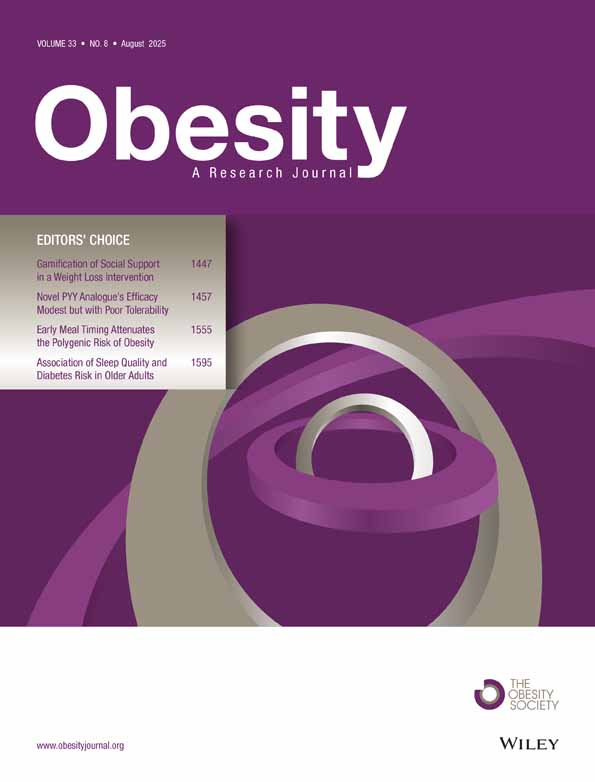Age at Arrival and Risk of Obesity Among US Immigrants
Abstract
Although immigrants are a rapidly growing subgroup, little is known about overweight/obesity among the foreign-born in the United States, especially regarding the effect of age at arrival. This study determined whether overweight/obesity prevalence is associated with age at arrival of immigrants to the United States. We analyzed data on 6,421 adult immigrants from the New Immigrant Survey (NIS), a study that is nationally representative of adult immigrants with newly acquired legal permanent residence (LPR). Multiple regression analyses tested the effects of duration of residence and age at arrival on overweight/obesity, defined by BMI of ≥25 kg/m2, and self-reported dietary change score. We found the relationship between duration of residence and overweight/obesity prevalence varied by age at arrival (P < 0.001). Immigrants ≤20-years old at arrival who had resided in the United States ≥15 years were 11 times (95% confidence interval: 5.33, 22.56) more likely to be overweight/obese than immigrants <20-years old at arrival who had resided in the United States ≤1 year. By comparison, there was no difference in overweight/obesity prevalence by duration among immigrants who arrived at >50 years of age. Higher self-reported dietary change is also associated with overweight/obesity. In conclusion, immigrants younger than 20 at arrival in the United States may be at higher risk of overweight/obesity with increasing duration of residence than those who arrive at later ages. Obesity prevention among young US immigrants should be a priority.
Introduction
The foreign-born population is a rapidly growing subgroup in the United States, currently representing almost 12% (or 37 million) of the national population (1); ∼20% of all children under the age of 18 in the United States are either first- or second-generation immigrants (2). Overweight and obesity prevalence in the United States have increased dramatically over the past decades (3,4), with minorities disproportionately affected (5,6).
Although at arrival immigrants are less likely than native-born individuals to be overweight and obese, increasing length of residence in the destination/receiving country is associated with higher risk of overweight and obesity (7,8,9,10). Increasing duration of residence leads to the adoption of the host country's dietary patterns (11,12,13), and may be especially important in the context of overweight and obesity. Past studies suggest that age at arrival of migrants is a critical variable, reflective of adaptive capability, education level, and motive for migration, and may be important to consider in acculturation to western lifestyle, specifically smoking (14), physical activity levels (15), self-assessed overall health (16), and socioeconomic status (17). For example, a study of Mexicans in Houston found that younger age at migration predicts history of smoking (14). Another study of Hispanic women in North Carolina found that participants who arrived in the United States at younger ages were more likely to report being physically active (15). Similar to these studies, much of the current literature highlights only specific regions of the United States and specific immigrant subgroups, decreasing their generalizability. There is little information on overweight and obesity among the foreign-born in the United States, especially regarding the effect of age at arrival on overweight and obesity.
Using the New Immigrant Survey (NIS), we examined whether the relationship between overweight and obesity prevalence and duration of residence differs by age at arrival. Second, we explored level of self-reported dietary change after migration as a possible explanatory factor in overweight and obesity prevalence.
Methods and Procedures
Data source
Data from the NIS, which is nationally representative of adult immigrants with newly acquired legal permanent residence (LPR) and their children, were used for this study (18). Specifically, we used data from the baseline cohort (NIS-2003) of sampled adult immigrants (n = 8,573). Details of NIS have been published elsewhere (19). Briefly, the sampling frame of NIS-2003 was based on electronic administrative records compiled by the United States Citizenship and Immigration Services and consists of adult immigrants admitted to LPR between May and November, 2003, and was stratified by four immigrant visa categories: employment principals, diversity principals, spouses of US citizens, and other immigrants; the first two strata were oversampled.
To avoid potential bias in our analyses, only subjects who reported migrating directly from their country of birth to the United States were included (n = 7,247), and those respondents who were overseas at the time of interview were excluded (n = 216). Of the remaining 7,031 subjects, those who did not provide data necessary to calculate duration of residence or age at arrival were excluded (n = 185). Finally, subjects providing missing height or weight data (n = 357) and unreliable BMI (≤12.5 or ≥42.5 kg/m2, n = 68) were excluded, resulting in a final sample size of 6,421.
Variables of interest
BMI was calculated from self-reported height and weight data, and was categorized as underweight (<18.5 kg/m2), normal weight (18.5 to <25 kg/m2), and overweight/obese (≥25 kg/m2). Duration of residence was calculated by subtracting year of migration from year of interview, and was categorized as follows: <1, 1 to <5, 5 to <10, 10 to <15, and ≥15 years. Year of migration was determined based on the respondent's answer to “In what month and year did you first leave (country of birth) to live in another country for at least 60 days?” Similarly, age at arrival was determined by subtracting years of duration from current age, and was categorized into the following groups: ≤20, 21 to 30, 31 to 40, 41 to 50, and >50.
Level of dietary change after migration was assessed by asking the following question: “Using a scale from 1 to 10, where 10 indicates exactly the same and 1 means completely different, how would you compare the similarity in diet in the food you now normally eat in the United States with the food you normally ate in your home country?” Based on the distribution of responses, we collapsed the scale into three levels of dietary change: low, moderate, and high.
Other variables of interest included current age (≤24, 25 to 34, 35 to 44, 45 to 54, 55 to 64, ≥65 years), sex, years of education (<12, ≥12), marital status (married, not married), and region of origin. Education was dichotomized because of the varying interpretation of years of education across countries. We considered 12 years of education as the cutoff point based on the mean and median of the sample distribution.
To determine region of origin, subjects were asked to respond to the question, “In what country were you born?” by choosing their country of birth from a list. Responses were then categorized into the following regions: Asia (including South, East, and Southeast Asia), Latin America and the Caribbean, Sub-Saharan Africa, Europe and Central Asia (including Russia, Eastern Europe, and Western Europe), and Middle East and North Africa.
Education level was considered a more appropriate indicator of socioeconomic status than income because of the loss of status that immigrants may have experienced; that is, income in the host country may not adequately reflect profession and/or education in the home country (20). The following variables were assessed but were not significant in regression analyses: health insurance, physical activity, smoking, alcohol use.
Statistical analysis
To explore baseline differences in overweight/obesity prevalence among immigrants who have resided in the United States for <1 year χ2-tests were carried out in sample categories, namely, sex, education, region of origin, and marital status. For the entire sample, multiple logistic regression analyses with overweight/obesity as the outcome variable were done with age at arrival and duration of residence as the exposures of interest. Although age at arrival and duration of residence were correlated (r = −0.404, P < 0.001), there was low multicollinearity, determined by a variance inflation factor of 1.22, allowing simultaneous assessment of both variables in models. However, adding current age with these variables resulted in high levels of multicollinearity (variance inflation factor = 6.58), which was expected, because current age is the sum of duration of residence and age at arrival. Therefore, we conducted separate analyses including duration of residence and current age in the first model, age at arrival and current age in the second model, and age at arrival and duration of residence in the third model. Because previous studies have shown sex differences in the associations between health behaviors and acculturation (9), the significance of sex interacting with age at arrival and duration of residence was assessed. We also tested the interaction between age at arrival and duration of residence to answer our main question of interest.
Bivariate associations of dietary change with duration of residence and age at arrival were done using χ2-tests. Ordinal logistic regression analyses with dietary change as the outcome were done to assess multivariable associations after verifying the proportional odds assumption was met. Categorical dietary change was the outcome variable, and age at arrival (continuous) and duration of residence (continuous) were the exposures of interest. Final models were determined by the backward elimination method.
Analyses were performed in SAS-callable SUDAAN (version 9.0, Research Triangle Institute, Research Triangle Park, NC) to account for the complex sampling design of NIS-2003. For all analyses, sample weights were applied, and statistical significance was considered at P ≤ 0.05.
Results
The majority of immigrants in this sample resided in the United States for ≤5 years, and over half of all migrants arrived at younger than 30 years of age (Table 1).
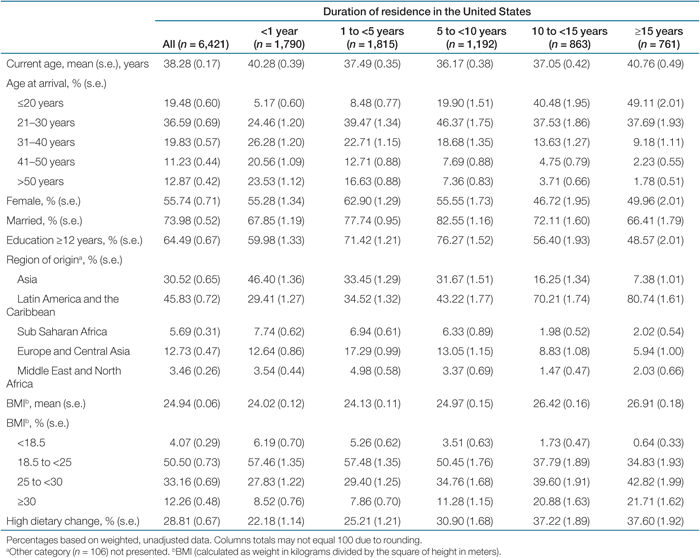 |
Overweight and obesity
Among immigrants who have resided in the United States for <1 year, males were significantly more likely to be overweight/obese (40.96%) than females (31.91%) (P < 0.001), and married immigrants are significantly less likely to be overweight/obese (33.86%) than unmarried immigrants (38.64%) (P < 0.001) after standardizing age directly to the distribution of the population. Overweight/obesity prevalence at arrival differed across regions of origin (P < 0.001); 23.74% of people from Asia were overweight/obese at arrival vs. 51.25% of immigrants from Latin America and the Caribbean. There was no significant association between overweight/obesity prevalence and education (P = 0.07). (Data not shown.)
1 shows that prevalence of overweight/obesity by sex among all age at arrival cohorts increases with greater duration of residence in the United States. Although immigrants ≤20-years old are significantly less likely to be overweight/obese than immigrants >50 years of age at arrival (13.54% vs. 42.29% in males, P < 0.001; 9.76% vs. 56.01% in females, P < 0.001), the difference in overweight/obesity prevalence by age at arrival groups narrows and is no longer significant for males at 5 years of residence (P = 0.15), and for females at 10 years of residence (P = 0.20).
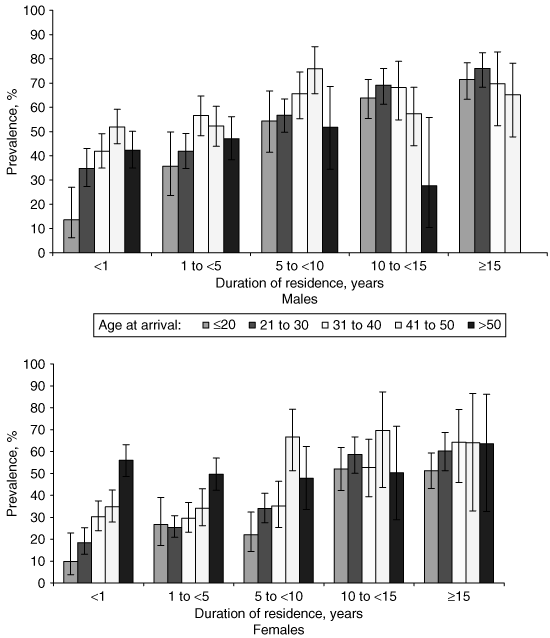
Overweight/obesity prevalence by duration of residence and age at arrival in the United States. Although overweight/obesity increases among all age at arrival groups with duration of residence in the United States, the greatest increases are observed among those immigrants who arrived at ≤20 years.
There was a significant interaction between sex and duration of residence (P < 0.01) and between sex and age at arrival (P < 0.001). Model 1 (Table 2) confirms our bivariate results, showing higher overweight/obesity prevalence with increasing duration of residence adjusted for current age, education, and region of origin. Model 2 (Table 2) shows that for both males and females, immigrants who were ≤20-years old at arrival are more likely to report being overweight/obese compared to all other age at arrival cohorts, controlled for current age, education, and region of origin. Results from both models also suggest sex differences in overweight/obesity prevalence by region of origin and education. With regard to education, female immigrants with >12 years of education were less likely to be overweight/obese than those with <12 years of education (Table 2); there was no association between education and overweight/obesity for males. A sensitivity analysis using education as a continuous variable indicates the associations between weight and education for both females and males remain the same.
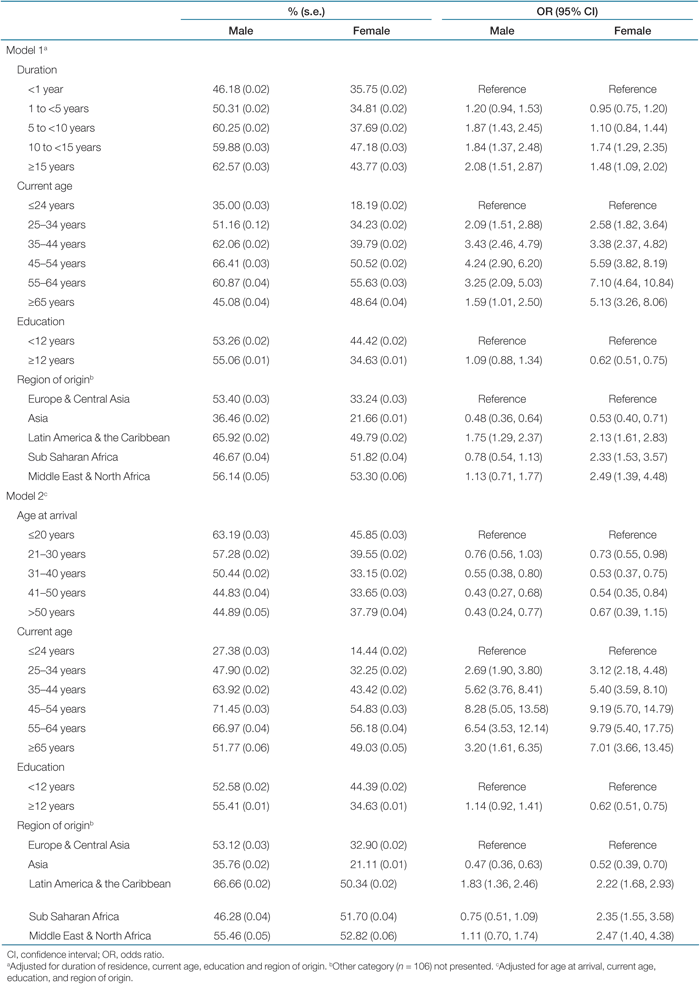 |
Adjusted for sex, education level, and region of origin, there was a significant interaction between duration of residence and age at arrival (P < 0.001) in predicting overweight/obesity, indicating that age at arrival modifies the relationship between duration of residence and overweight/obesity prevalence among immigrants in the United States.
Further analyses, stratified by age at arrival group (Table 3), show the largest difference in overweight/obesity prevalence by duration of residence was observed in the youngest age at arrival group. Trends were similar between males and females; therefore, the overall results adjusted for sex are presented. Immigrants ≤20-years old at arrival who had resided in the United States ≥15 years were 11 times more likely to be overweight/obese than immigrants <20-years old at arrival who had resided in the United States ≤1 year (OR = 10.96, 95% confidence interval: 5.33, 22.56; P < 0.001). By comparison, among immigrants >40 years of age at arrival, those having resided in the United States for ≥10 years are no more likely to self-report being overweight/obese than those who have recently arrived (P = 0.42).
 |
Dietary change
Self-reported high dietary change after migration was found to be significantly and independently associated with overweight/obesity, controlling for age at arrival, duration of residence, sex, and education. Specifically, immigrants reporting high dietary change are 1.32 times more likely to self-report being overweight/obese compared to immigrants reporting low dietary change (95% confidence interval: 1.13, 1.53; P < 0.001) (data not shown).
Immigrants who have been in the United States longer are significantly more likely to report high dietary change from premigration diets than recently arrived immigrants (P < 0.001) (Table 1). Overall, those immigrants who are youngest at arrival are significantly more likely to report high dietary change, whereas immigrants oldest upon arrival are more likely to report low dietary change (P < 0.001) (2).
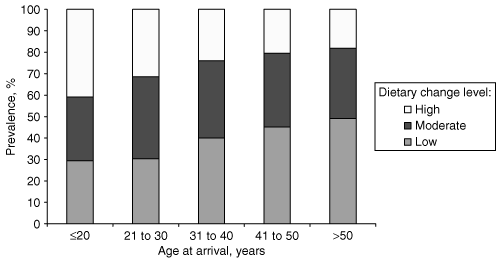
Dietary change level by age at arrival to the United States. A negative linear trend is observed in age at arrival and the percentage of immigrants reporting high dietary change.
Adjusted for sex, education, and region of origin, there is a significant interaction found between age at arrival and duration of residence in predicting dietary change (P = 0.03), indicating that age at arrival of immigrants also modifies the relationship between duration of residence in the United States and dietary change.
Discussion
We found that immigrants who arrive in the United States before the age of 20 years are more likely to be overweight or obese with increasing duration of residence than immigrants who arrive at later ages. Increasing duration of residence in the United States is significantly associated with greater odds of overweight/obesity, and age at arrival significantly modifies this relationship. We also found that the relationship between self-reported dietary change and duration of residence is modified by age at arrival; immigrants who arrive in the United States at younger ages are more likely to report high levels of dietary change than immigrants who arrive at older ages. Lastly, dietary change was associated with overweight and obesity; immigrants reporting high dietary change are more likely to be overweight and obese than immigrants reporting low dietary change.
The differences in overweight/obesity development and dietary change by age at arrival can potentially be explained by several factors: increased exposure and adaptability of younger immigrants to US lifestyles, differences in motives for migration by age group, and health selection for migration later in life. Compared to immigrants who arrive in the United States at later ages, immigrants who migrate during childhood and adolescence are more exposed to the lifestyles of their native-born counterparts because they are more likely to receive schooling in the United States, and are more likely to marry native-born Americans (21). Older immigrants are less likely to acculturate or build new social networks because they usually migrate to rejoin family members already in the United States (22), and the presence of a network of people of the same ethnicity is likely to delay or inhibit acculturation (10); young immigrants migrate either accompanying their families or for educational and/or economic opportunities and, as a result, may be more willing to acculturate (23). Lastly, health selection may operate in one of two ways on immigrants arriving in the United States at older ages. Consistent with the healthy immigrant effect, only those elderly individuals who are positively selected for health will migrate (24,25) and, furthermore, only those who remain healthy will stay in the United States, whereas unhealthy individuals may return to their home countries (26). Conversely, there is the possibility of negative selection (24), whereby elderly individuals migrate to seek care, and by accessing health services are less likely to develop overweight/obesity after arrival in the United States.
This study's finding that level of dietary change after migration is significantly associated with overweight/obesity is consistent with previous studies that have documented increased fat and sugar intake and decreased fruit and vegetable intake postmigration (11,27,28), implying that immigrants may be shifting toward more unhealthy dietary patterns after arrival in the United States.
Region of origin emerged as an important factor in overweight/obesity and dietary patterns in this study. Immigrants from Asia are the least likely to be overweight/obese and are the least likely to report high dietary change, whereas immigrants from Latin America and the Caribbean are the most likely to be overweight/obese and after Sub-Saharan Africans and are the most likely to report high dietary change. These findings are consistent with the literature on increasing obesity among Latin American immigrants in the United States (29,30).
Diversity between traditional and US diets, as well as increasing availability of western foods in certain regions could be explanations for the differences in dietary change by region of origin. For example, European and North American diets are relatively similar and, therefore, high dietary change may not be perceived among European immigrants after migration to the United States. However, we found that immigrants from Asia, whose traditional diets differ considerably from the North American diet (11,31,32), were no more likely to report high dietary change than European immigrants. For recently arrived immigrants, this can be explained by the increased availability and consumption of western foods by Asians before migration (12). Conversely, a study of Sub-Saharan African immigrants, the most likely to report high dietary change in our sample, noted increased consumption of western foods that were not available in Africa (27).
There were some limitations to our study. Although the NIS study is designed to be longitudinal, only the NIS-2003 baseline data were available for this study; the cross-sectional nature of this study cannot allow us to make any inferences regarding causality. The sampling method of selecting new immigrants for the NIS study resulted in a disproportionate number of immigrants who have resided in the United States for ≤5 years; furthermore, NIS samples only immigrants with newly acquired LPR status, who may be different from immigrants without LPR. Precategorized countries of birth did not allow the examination of differences within regions (e.g., South Asian vs. other Asian). Our sample also includes immigrants who migrated directly from their country of birth to the United States and may have migrated elsewhere afterward, eventually returning to the United States. In these cases, duration of residence is overestimated, and thus observed increases in weight may have actually occurred within a shorter period than calculated in this study. Although our analysis could not account for cohort effects related to year at migration, previous research implies that overall, patterns of health assimilation including BMI are similar across cohorts of immigrants (33). Lastly, height and weight data are self-reported, thereby leading to potential recall and misreporting biases (34,35). Although the dietary change score has not been validated, inclusion of a dietary change component in exploring overweight/obesity among immigrants and data that is nationally representative of adult immigrants with newly acquired LPR allowed us to analyze a unique research question with relevant public health implications.
Although previous studies have observed increasing trends in overweight and obesity among second- and third-generation adolescent immigrants (36), our results have clearly indicated that young first-generation immigrants are also experiencing rises in overweight and obesity and, in fact, to a greater degree than the national population. At arrival, immigrants aged ≤20 years are much less overweight and obese (12%) than the US population in the same age group (35%) (37), and at 15 years of duration in the United States, the overweight/obesity prevalence of the same age at arrival cohort (61%) has almost converged to the national overall prevalence (66%) (38). Although the age group under 20 includes both children and adolescents, our analysis showed no difference between younger age subgroups by overweight/obesity prevalence, suggesting that it is important to intervene among all immigrants who arrive at ≤20 years of age, regardless of specific age of migration.
In summary, immigrants who arrived in the United States at younger ages may be at higher risk of overweight/obesity with duration of residence than immigrants who arrive at later ages. Immigrants who are younger at arrival are also more likely to report a high level of dietary change postmigration, which is associated with overweight and obesity. Our findings emphasize the need for aggressive overweight and obesity prevention programs tailored to immigrant youth in the United States.
Acknowledgment
We thank Solveig Argeseanu Cunningham, for her thoughtful review of the manuscript prior to submission. This work was partially supported by the Global Health Institute, Emory University.
Disclosure
The authors declared no conflict of interest.



